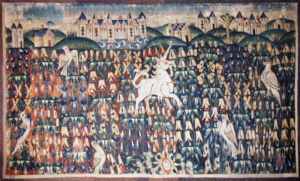Object of the Month: January 2017
Mille-Fleurs Tapestry
Franco-Flemish, c. 1480
Gift of Z.E. Marguerite Pick in memory of Misty
Click on the links throughout the article to view additional artists’ works and reference material.
Mille fleurs tapestries are those with a myriad of small flowering plants sprinkled across a dark blue or red or sometimes dark brown background. Mille-fleurs is French, literally translated “thousand flowers.”
Tapestries have been around for centuries, and their use was not merely decorative as we might assume in today’s culture. These incredible textiles are constructed from a considerable amount of wool threads with varying amounts of silk, silver, and gilt yarns for beauty and richness. Their size and material provided insulation in the drafty, cold interiors of medieval castles and homes, and they could easily be rolled or folded and transported, which was a great advantage to those living back then.
However, the subject matter of tapestries varied significantly focusing on scenes from history, allegory, mythology, Scripture, and romance with coats of arms and decorative elements included too. The mille fleurs decoration, however, wasn’t necessarily linked to any specific subject, but sometimes might be; instead, as one writer describes, the flowering background is more of “an expression of the universal human love of fresh flowers and the wish to have bouquets of fields of them covering the walls”—especially in the barren winter months.
Although as symbols, mille fleurs particularly lend themselves to allegorical and romantic themes “furnishing a slight subject for tapestries entirely sprinkled over with sprightly growing plants” with the “now and then active dogs, strange beasts or an occasional human figure [who] claimed a space.”
M&G’s tapestry certainly meets this composition depicting the imaginary animal, the unicorn, with various birds (perhaps a falcon on the right) against the mille-fleurs background. The upper portion reveals a landscape of mountains and hills with tall grasses, trees, various buildings, towers, and castles—including one with a moat full of wavy, active water.
The unicorn has quite a history—through second-hand accounts, of course. This mysterious animal is described in classical references as having goat-like features, hence the cloven hooves and beard; he hunts in the mountains and is a very strong, fast animal that no one could capture. He is depicted on cylinder seals as far back as Babylon and Assyria and referenced in the fifth-century Greek writings by Artaxerxes’ physician, Ctesias. Other references of the unicorn appear in the old bestiaries.
Philippe de Montebello, former director at the MET, explains the interest in animals both real and imagined, “During the Christian era, the expressive power of animals perhaps reached its height in the Latin bestiaries of the twelfth and thirteenth centuries. These books, labored over by the monks who copied them over and over again, combined factual, realistic observations of animal life with legend and served as allegorical texts for teaching clergy and laymen alike. Animals in their amazing diversity yielded illustrations and promulgations of desired behavior as well as warnings against misbehavior or evil.”
Of all the beasts, the unicorn (sometimes called the Monoceros) has become legendary. He symbolizes purity, and since the unicorn could only be captured by a virgin because of his attraction to her love of chastity, the hunt for the unicorn became an allegory of the incarnation of Christ as well as an allegory of romance and marriage. Thus, the unicorn appears in both secular and religious art—even on some vestments worn by priests.
It is said that the horn of the unicorn possessed the virtue of detecting poison as well as the power to render the poison harmless. According to legend the animals of the forest would not drink from a pool until the unicorn had first purified it with his horn. This story is depicted in one of the great unicorn tapestries in the collection at the Cloisters in New York.
The unicorn is often depicted in a place of colorful and abundant fauna, referencing Paradise—sometimes in connection with scenes of Creation and the Fall. He usually stands in the middle or off to the edge, alone or distant from the other animals, and sometimes near a body of water, perhaps immersing his horn.
For the gardeners and lovers of flowers, some of the plants possibly depicted include: foxglove, day lilies, rowan, and the daffodil. Look closely to identify these symbolic plants:
- Cuckoo Flower, which Pliny claims can repel snakes and “drive away melancholy and makes people happy in their hearts.”
- Blue Bell blossoms, which supposedly when a bluebell is suspended above the threshold, “all evil things will flee therefrom.”
- Wild Pansy, a symbol of remembrance and meditation
- English Daisies, which signify the joy of Easter, and in medieval Germany these were called massliebe or “measure of love” suggesting that even then girls plucked the petals saying, “He loves me, he loves me not.”
Without knowing more about the designer, weavers and past owners, it’s difficult to know the intention of the tapestry; however, its symbolism provides insight for both the secular and spiritual just as it did in its original home. The concept of appreciating nature and learning from our observation of it wasn’t new in the old bestiaries or even Aesop’s fables. King Solomon, the wisest man to ever live, exhorts the reader in his wisdom writings of Proverbs and Ecclesiastes to observe God’s creation and find its parallels for application and improvement in our own daily living—a good start for a New Year.
Erin R. Jones, Executive Director
Published in 2017
